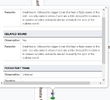A bright fireball with a long path flowed earlier! This is how the fireball at 21:58:04 on October 27, 2023 was captured by a camera facing southeast from Hiratsuka's home. I actually saw it, and it was very beautiful, flowing like jewels falling.
Apollo-type near-Earth
#小惑星 2023 UJ9 passed approximately 740,000 km from the earth's center (approximately 1.9 times the distance to the moon) at around 11:02 JST on October 19, 2023. October 20 It was discovered by JPL SynTrack Robotic Telescope, Auberry in California, USA, and has an estimated diameter of 8-17 m.It is a celestial object that approaches the Earth from the direction of the Sun.
https://ssd.jpl.nasa.gov/tools/sbdb_loo
Rocks from the edges of the solar system reach Earth driven by encounters with other stars
Published: October 23, 2023 1.27pm EDT Updated: October 24, 2023 3.44am EDT
Un nuevo estudio sugiere que ciertos meteoritos llegados a la Tierra a velocidad inusual proceden de una región remota de nuestro sistema solar (la nube de Oort) donde se produjo el paso de una estrella binaria.

theconversation-com.translate.goog
Behind that title, as surprising as it is suggestive, there is about a year of research into a fascinating space rock that flew over Finland in the form of a fireball just one year ago: on October 23, 2022. Prepublished in the ArXiv repository
, our Research will appear shortly in the
prestigious magazine Icarus .
It all started when Jaakko Visuri, co-author of the work and in charge of scientific exploitation of the Finnish
Ursa network , asked me for my opinion shortly after the fireball, baptized as FH1, was detected. We analyzed it in
my research group at the Institute of Space Sciences (CSIC) with great affection because, after several decades detecting meteoric bolides, our Finnish colleagues had identified the first hyperbolic meteoroid over Finland.
It was up to us to give an expert and independent opinion to know the origin of that small rock measuring a few centimeters, which reached the Earth from a
hyperbolic orbit (that is, an open orbit with an eccentricity greater than 1) and hit with an almost grazing path, producing what is known as a
skimming car .
It should be said that these types of events give more reason to the enormous effort of the citizen science project
of the SPMN-CSIC Network , born 27 years ago. Thanks to it we can catalogue, with the support of professional and amateur astronomers, the large bolides recorded over Spain. We had been searching for years to detect a similar event.
An interstellar traveler or a false prophet?
The collaboration between our racing car networks goes back a long way, due to the excellent work of Visuri's predecessor, the specialist
Esko Lyytinen . With it we co-discovered that some
asteroids close to Earth can cause projectiles that are not without risk during close encounters with our planet .
This time we had another fascinating object of study: a rock whose orbit,
a priori , seemed to indicate that it came from interstellar space.
Controversial catalog
Until recently we did not know for sure the existence of hyperbolic projectiles that had reached the Earth. The scant evidence that existed came from some objects
identified by our research group in the
debated catalog of meteoroid impacts detected by United States spy satellites.
Known by the acronym of the center for the study of minor bodies,
Center for Near Earth Objects Studies (CNEOS) , this catalog does not provide an error range to determine the
radiant – region of the celestial vault from which each of these bolides appears to emerge. – nor its speed, so the error made in determining the orbit is unknown. This has unleashed controversy over its use, particularly speculative when the arrival of a projectile of anomalous composition and extraterrestrial origin was suggested: the well-known
IM2 event .
In our previous study, where we discovered the hyperbolic nature of the orbit of that rock, we pointed out that it was not unusual,
but probably an alloy of iron and nickel that characterizes metallic meteorites .
In the
new work we have compared the Finnish car FH1 with other cars that reached the Earth from hyperbolic orbits, cataloged in the CNEOS database.
We should expect the orbits of these interstellar visitors to occur randomly. However, our work shows that four of the CNEOS interstellar meteoroids come from orbits relatively close to the ecliptic plane – an imaginary plane defined by the Earth in its annual movement around the Sun – and from its radiant in the celestial vault that is located in the constellation of Gemini.
The meeting with the star Scholz
It is so extremely unlikely that this would happen randomly that it raised our suspicions and led us to investigate more plausible scenarios. For example, it could be that these projectiles came from our solar system and that there were inaccuracies in the measurement of their speed of arrival at Earth. Or that they would have occurred as a result of the acceleration provided by encounters with planets or other bodies.
In our paper we hypothesize that hyperbolic impactors are celestial bodies native to our solar nebula, perturbed by encounters with massive objects. More precisely, we propose that the trajectory of both IM2 and FH1 align in time and direction with the flyby of a
binary star, known as Scholz , which crossed the outermost region of our solar system, the
Oort cloud , just a few years ago. 70,000 years. That low-mass star – about 165 times that of the planet Jupiter – was
cataloged by the Wide-field Infrared Survey Explorer (WISE) infrared space telescope as WISE J072003.20-084651.2.
The encounter with other stars has always been considered a precursor to waves of icy bodies stored in these remote regions. However, it all depends on how close to the Sun the stars pass through the solar system. In the case at hand, Scholz did it at about 82 kilometers per second and about 68,000 times the average distance from the Earth to the Sun. Given that high speed and relative proximity, we find it plausible that small bodies in the Oort cloud, or even from the outer cloud of that binary star, could be injected towards Earth.

Representation of the celestial vault in which the apparent movement of objects is indicated from their geocentric radiants based on the backward orbital integration of their orbits. Shown in the diagram is the Scholz star, the Finnish bolide FH1, the origin of the interstellar objects 1I/'Oumuamua and 2I/Borisov. The 6 events of the CNEOS catalog have been marked with the date of the encounter with the Earth in which the average deviation found for the 17 fireballs studied from that catalog has been included. All non-hyperbolic CNEOS events are also depicted, along with a central point in the Gemini constellation. The markers represent the position of the radiant at the time of impact or at the current time in the case of Scholz. The plane of the ecliptic is also indicated in yellow. Peña-Asensio, Visuri, Trigo-Rodríguez et al. (2023)
An elegant explanation
This explanation would elegantly resolve the origin of the majority of rocks that have arrived to date on our planet with slightly hyperbolic velocities. Such objects would probably be found in the Oort cloud, being gravitationally propelled towards that distant region as a consequence of the gravitational dispersion that the giant planets caused on small bodies in our planetary system, in a dynamical model known as the
great tack . This paradigm, which allows us to understand the current structure of our planetary system, was proposed by the team of the famous Italian dynamicist
Alessandro Morbidelli .
In this way, asteroids, comets and small rocks would be propelled into very long period orbits located in the Oort cloud. These objects in orbits very distant from the Sun could acquire excess speed from relatively small gravitational perturbations generated by the passage of stars like Scholz. There would be no need for very close encounters, as long as they were facing the right direction and at the right time.
We know that objects of larger interstellar origin, such as 1I/Oumuamua' or 2I/Borisov, can survive periods of time long enough to fortuitously reach other planetary systems other than those that formed them. However, this does not seem to happen as effectively to rocks measuring a few meters as those produced by these hyperbolic bolides. That would explain why interstellar projectiles that cause bolides are so rare.
Because, in some way, it is very possible that the rocks propelled into interstellar space in these formative stages of planetary systems end up being destroyed by physical processes (cosmic radiation, temperature changes, erosion caused by collisions...) before reaching other systems. stellar.
Whatever the reason, it exemplifies that astronomy is such a fascinating science that, almost without wanting to, we find ourselves studying chance events of extrasolar archeology that allow us to know what happens in encounters between planetary systems. These clues seem fundamental to establish criteria that allow us to identify meteorites arriving from other environments in our galaxy. For this reason, we will continue scanning the sky and capturing cars waiting to recover a true interstellar messenger.
A very bright fireball flowed! I can't even beat the moon!2023.10.27 21:58:05~Southward camera from Kawasaki City
#meteor #火球 #流れ星 #流星
Planet-9
New entry in my videoblog "18E6km. A space trip"Ep 8. Candidate discarded some insights into my research work and questions about magnetic whipping, Roman calendar
cycles, etc.
AMS reports show incoming meteors continue to fragment upon entry. See chart below.
















